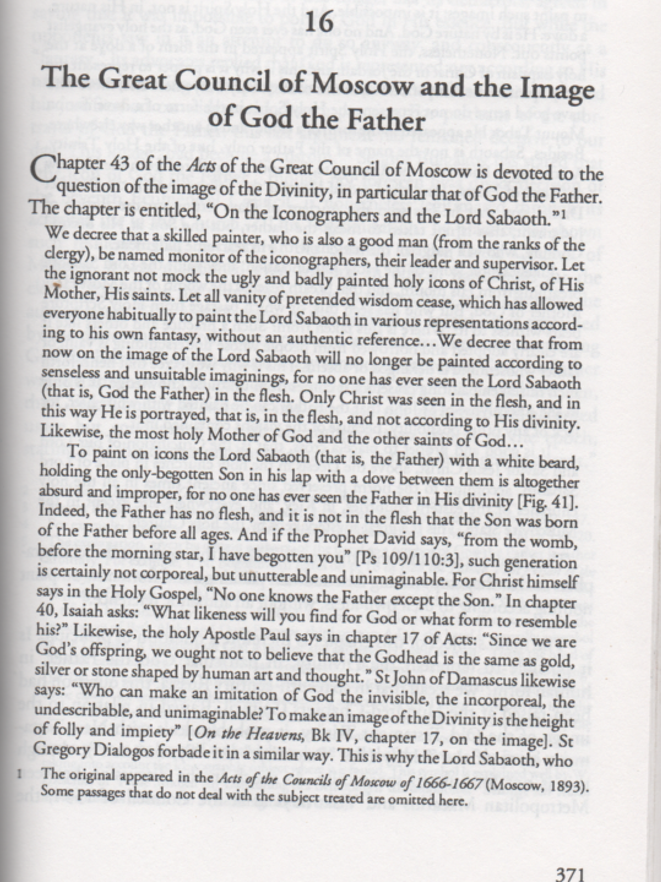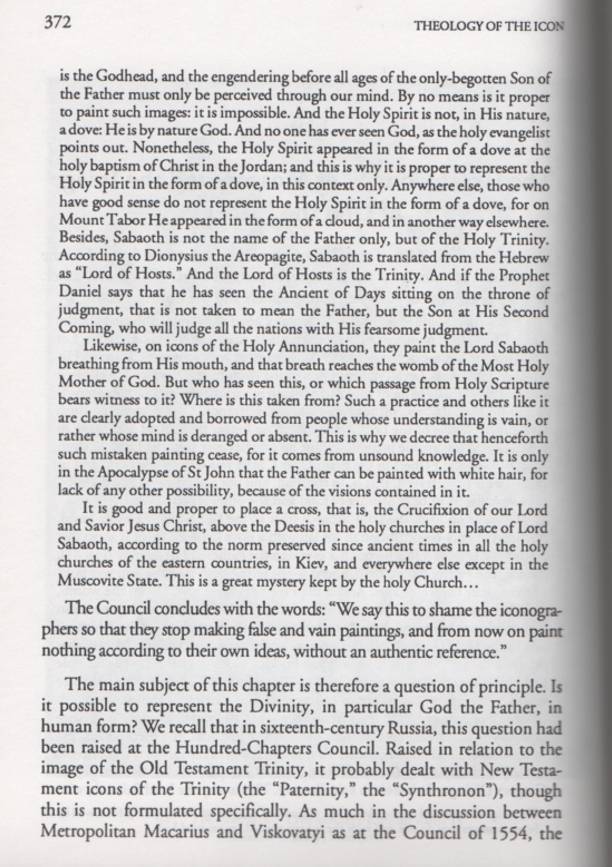Council of Moscow, an Eastern Orthodox council, identifies Jesus, not the Father, with the "Ancient of Days" in Daniel 7.
- Type
- Book
- Source
- Leonid Ouspensky Non-LDS
- Hearsay
- ReprintTranslation
- Reference
Chapter 43 of Acts of the Councils of Moscow (1666-1667) in Leonid Ouspensky, Theology of the Icon, 2 vols. (trans. Anthony Gythiel; Crestwood, New York: St. Vladimir’s Seminary Press, 1992), 2:371-72
- Scribe/Publisher
- St. Vladimir’s Seminary Press
- People
- Leonid Ouspensky
- Audience
- Reading Public
- Transcription
We decree that a skilled painter, who is also a good man (from the ranks of the clergy), be named monitor of the iconographers, their leader and supervisor. Let the ignorant not mock the ugly and badly painted holy icons of Christ, of His Mother, His saints. Let all vanity of pretended wisdom cease, which has allowed everyone habitually to paint the Lord Sabaoth in various representations according to his own fantasy, without an authentic reference . . . We decree that from now on the image of the Lord Sabaoth will no longer be painted according to senseless and unsuitable imaginings, or no one has ever seen the Lord Sabaoth (that is, God the Father) in the flesh. Only Christ was seen in the flesh, and in this way He is portrayed, that is, in the flesh, and not according to His divinity. Likewise, the most holy Mother of God and the other saints of God . . .
To paint on icons the Lord Sabaoth (that is, the Father) with a white beard, holding the only-begotten Son in his lap with a dove between them is altogether absurd and improper, for no one has ever seen the Father in His divinity. Indeed, the Father has no flesh, and it is not in the flesh that the Son was born of the Father before all ages. And if the Prophet David says, “from the womb, before the morning star, I have begotten you” [Ps 109/110:3], such generation is certainly not corporeal, but unutterable and unimaginable. For Christ himself says in the Holy Gospel, “No one knows the Father except the Son.” In chapter 40, Isaiah asks: “What likeness will you find for God or what form to resemble his?” Likewise, the holy Apostle Paul says in chapter 17 of Acts: “Since we are God’s offspring, we ought not to believe that the Godhead is the same as gold, silver or stone shaped by human art and thought.” St. John of Damascus likewise says: “Who can make an imitation of God the invisible, the incorporeal, the indescribable, and unimaginable? To make an image of the Divinity is the height of folly and impiety” [On the Heavens, Bk IV, chapter 17, on the image]. St. Gregory Dialogos forbade it in a similar way. This is why the Lord Sabaoth, who is the Godhead, and the engendering before all ages of the only-begotten Son of the Father must only be perceived through our mind. By no means is it proper to paint such images: it is impossible. And the Holy Spirit is not, in His nature, a dove: He is by nature God. And no one has ever seen God, as the holy evangelist points out. Nonetheless, the Holy Spirit appeared in the form of a dove at the holy baptism of Christ in the Jordan; and this is why it is proper to represent the Holy Spirit in the form of a dove, in this context only. Anywhere else, those who have good sense do not represent the Holy Spirit in the forms of a dove, for on Mount Tabor He appeared in the form of a cloud, and in another way elsewhere. Besides, Sabaoth is not the same of the Father only, but of the Holy Trinity. According to Dionysius the Areopagite, Sabaoth is translated from the Hebrew as “Lord of Hosts.” And the Lord of Hosts is the Trinity. And if the Prophet Daniel says that he has seen the Ancient of Days sitting on the throne of judgment, that is not taken to mean the father, but the Son at his Second Coming, who will judge all the nations with His fearsome judgment.
Likewise, on icons of the Holy Annunciation, they paint the Lord Sabaoth breathing from His mouth, and that breath reaches the womb of the Most Holy Mother of God. But who has seen this, or which passage from Holy Scripture bears witness to it? Where is this taken from? Such a practice and others like it are clearly adopted borrowed from people whose understanding is vain, or rather whose mind is deranged or absent. This is why we decree that henceforth such mistaken painting cease, for it comes from unsound knowledge. It is only in the Apocalypse of St John that the Father can be painted with white hair, for lack of any other possibility, because of the visions contained in it.
It is good and proper to place a cross, that is, the Crucifixion of our Lord and Savior Jesus Christ, above the Deesis in the holy churches in place of Lord Sabaoth, according to the norm preserved since ancient times in all the holy churches of the eastern countries in Kiev, and everywhere else except in the Muscovite State. This is a great mystery kept by the holy Church . . .
- Citations in Mormonr Qnas
The B. H. Roberts Foundation is not owned by, operated by, or affiliated with the Church of Jesus Christ of Latter-day Saints.


